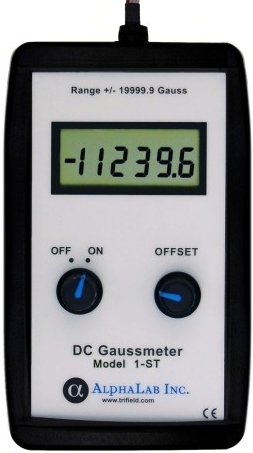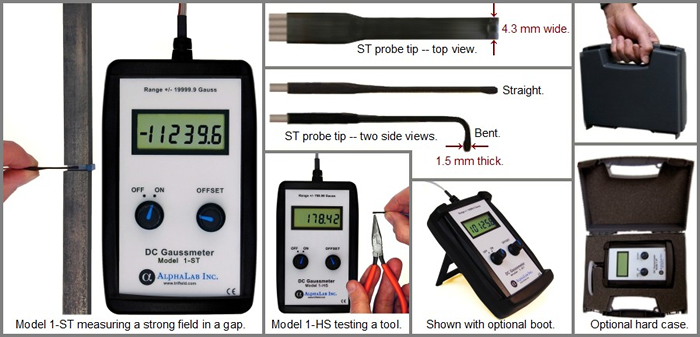DC Gaussmeter Model 1 (ST )The standard (ST) version of the DC gaussmeter Model 1 reads magnetic field strength ("flux density") up to 19,999.9 gauss. (Magnetic pull force can be calculated from these readings.) The meter is designed to measure magnets and DC solenoids. The strongest rare-earth magnets have a field strength of up to 14,000 gauss in a gap configuration, which is 7000 gauss on each magnet face if the two magnets in a gap were separated. Therefore, with a range of 19,999.9 gauss, the ST can easily measure the strength of any type of magnet in any configuration. Because of the high 5 1/2 digit dynamic range (100 times wider range than typical 3 1/2 digit meters), it can measure small changes of as little as 1/10 gauss in any field less than 20,000 gauss (20 kG). This precision allows the user to track tiny changes in magnetization-- a useful feature for determining if a magnet is being damaged by handling or whether a given magnet is fully magnetized. The meter has been optimized for easy use. It begins reading 1/2 second after it is turned on and updates four times a second. Stability is excellent, with noise level of only 0.1 gauss. Reproducibility at constant temperature is better than one part in 5000, and is generally only limited by the user's ability to position the sensor on the same part of the magnet as was originally measured (field strength varies across the face of most magnets). Full response time to a rapid field change is only 1/4 second. No setup is needed, and there is only one range (display reads from 0.0 to 19,999.9 gauss, with negative sign if polarity is negative). Therefore, artifacts due to autoranging do not occur. These features make the Model 1 faster to use than any other digital gaussmeter, while still very easy to use. The only control is the "OFFSET", which allows subtraction of ambient field up to 10 gauss. (Turn this knob to the center position if not needed).
The high-stability (HS) version (second from left) measures weaker fields. It has a resolution of 0.01 gauss, which is better sensitivity by a factor of 10 than the ST. However, the maximum measurable field of the HS is 799.99 gauss. A field of 800 gauss or more will show as over-range ("1 - - - . - -"). The HS will display correctly again as soon as the field drops below 800 gauss. Noise level of the HS is 0.01 gauss, which is 1/10 that of the ST. The HS version is used to test if metal items have been properly demagnetized. It can also read the strength and direction of the Earth field (which is roughly 1/2 gauss) as well as the far-field pattern around magnets. However, the HS cannot read the field strength near strong magnets, and is only used if the extra factor of 10 in sensitivity is needed. If unsure of which version to use, you can order one version, test it, and exchange for the other. Only the additional shipping charge will apply. Accuracy of both ST and HS is 1% of the reading at room temperature (16°C to 29°C or 61°F to 84°F), and 2% of reading in the full temperature range of -4°C to 65°C (25°F to 149°F). Both models are "vector component" meters, as are most Hall-Effect gaussmeters. That is, they detect the component of the field that points in the same direction as the sensor. If the sensor is flipped 180 degrees, the reading will reverse polarity. Also, the meters will read zero if the sensor is oriented exactly perpendicular to the field. Therefore, to measure the correct magnitude of the field, the sensor direction must be parallel to the field direction. The parallel direction can be determined easily however, because "parallel" is the sensor orientation that produces the highest reading on the display. The sensors of both versions have been designed for ease of use. The sensor is at the end of a very flexible 100 cm (40") cable and can be easily held flat against a magnet face. This correctly orients the sensor parallel to the field direction of most magnets for accurate readings. The ends of the sensors can be bent to a right angle (as shown above) and then back to straight thousands of times. This right angle bend is not required for most types of measurements but it is needed to measure the field inside a solenoid. Both versions truncate (blank) the zeros, so only the necessary digits are displayed. These meters measure DC only, and the probes with cable are not detachable.
The tip of the ST external probe is slightly less than .060? (1.5 mm) thick and 0.170" (4.3 mm) wide. (The HS probe tip is 0.075" or 1.85 mm thick.) It can be placed precisely on any region of a magnet or inside a gap. The sensitive area is 2 mm back from the end of the probe and the measurement direction is parallel to the thinnest dimension of the probe. The actual sensor area is a square only 1/5 mm on a side. When measuring the surface of magnets, magnetic gaps, or the field inside solenoids, a small external probe on a flexible cable (like the ST and HS) is essential so that you can place the sensor exactly where you want to. When doing measurements with a gaussmeter, please note that the actual field at the surface of a magnet is at most one half of the rated residual magnetism for that magnetic material. If a rare-earth magnet is rated at 14,000 gauss for example, a bar magnet made from that material will have an actual field of at most 7000 gauss at the north pole and -7000 gauss at the south pole. The readings may be even less than 7000 gauss. If the bar magnet is thin (that is, its length is at least 10 times its diameter) then the field will be close to 7000 gauss. If the bar magnet?s length is less than 10 times its diameter, the field at either pole will be weaker. For example, if the magnet is in the shape of a cube, the surface field will be 4500 gauss or less. The full 14,000 gauss field can only be created if two bar magnets are in a gap configuration. This means that the magnets are held close together so that one south pole of one magnet is held very close to one north pole of the other. The distance between the magnets (the gap width) must be small compared to the magnet diameters, and each magnet?s length must be at least 10 times its diameter. Then the field in the gap will be approximately the full value of the magnetic material?s residual magnetism, which is 14,000 gauss in this example. Magnets that are flat (like a pancake) have a very low surface field. The magnetic pull force between equal magnets or between a magnet and a steel or iron block can be calculated from field strength. This force is approximately [Force in grams] = 0.00016 x [Field on the magnet face in gauss]2 x [Magnet face area in square cm].) The included standard 9-volt battery lasts about 40 hours of "on " time in the ST version (drain = 6 ma), or 20 hours in the HS version (drain = 12 ma). LOW BATTERY indicator shows when about one hour of battery life remains. Options include a detachable rubberized side cover or "boot" which makes the meter breakproof from a six-foot drop, and allows it to stand up as shown ($9 USD for boot). Another option is a hard case ($18 USD). A certificate is not included. Although calibration is normally not required within 10 years, we can perform a calibration on this meter at any time for $30.This calibration will include a NIST-traceable certification, and the calibration/cert can also be ordered initially with the meter for $30. Accuracy of the meter is still guaranteed to the specifications above even without optional calibration/cert. More Information about Magnetic Fields
|

